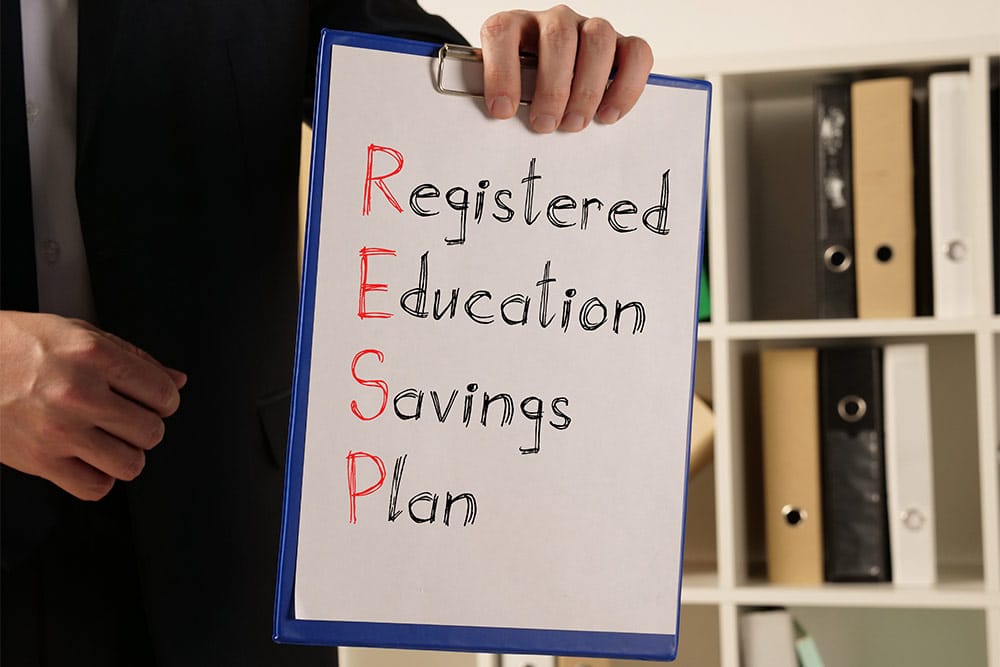A Registered Education Savings Plan, or RESP, is a tax-free investment account that allows parents and families to save for a child’s post-secondary education. Oftentimes, families in Canada save money for their children to use for their post-secondary education in a Registered Education Savings Plan (RESP). Preparing early for university, college or a training program puts your child on a path to financial success.
Want to save for your child’s post-secondary education? We’ve got all the information you need, right here. Our experienced, licensed financial Associates are happy to help you with all of your RESP questions and other financial needs.
How do RESP’s Work?
Investing in an RESP will help you save money for your child’s education. These investments grow tax-free, and qualify for government contributions like the Canada Education Savings Grant (CESG) and also could include the Canada Learning Bond (CLB).
There are three main participants in an RESP:
- The subscriber: A subscriber is the person who opens an RESP and makes contributions to it. Often, it is the parents of the child who is the subscriber.
- The promoter: A promoter is the financial institution holding the RESP who pays out funds when the child attends an accredited post-secondary education school.
- The beneficiary: The child who will ultimately receive the money contributed to the RESP.
A subscriber opens an RESP account in the child’s name and makes regular deposits in the account to cover educational expenses. After highschool graduation, If a child enrolls as a full-time student in a recognized post-secondary educational facility, the promoter will distribute any money and interest earned on the child’s behalf.
An RESP can generally stay open for as long as 36 years, so the child doesn’t have to go straight from high school into university or another education program. Your Experior Associate can help make sure it is the right plan for your child.
Types of RESPs
Three types of RESP plans are available for your child and you should select the one that best suits your family and your particular situation.
Individual Plan
Only one person can be the beneficiary of an individual RESP. The advantage of this plan is that anyone can open one—no family relation is required. For example, you can open an RESP for your niece and another one for a family friend’s child. You can also open one for yourself or another adult.
Family Plan
This kind of RESP is beneficial for families with more than one child, as you can name more than one beneficiary. To get access to the funds you’re giving away, the beneficiaries you name in your will, must be your children, stepchildren, grandchildren, or siblings related to you by blood or adoption. You cannot open a Family Plan RESP for yourself, as you are not considered a blood relative. However, the advantage of a family plan is that any beneficiary can use the funds.
Group Plan
A group RESP, which is sometimes called a group scholarship trust, is a plan that pools contributions from multiple families to pay for either post-secondary education or college savings. The funds you contribute to the RESP are then invested in government-approved, low-risk investment products. You or your beneficiaries can collect income tax-free when you receive payments yearly during the first four years of post-secondary education.
Some disadvantages of group RESPs are that they have restrictions on the types of investments you can make and charge higher fees than other types of RESP plans. Each group has its own rules and procedures, but you are typically asked to commit to a strict payment schedule and to name one child as the beneficiary.
How to Open an RESP?
Opening an RESP is fast and easy. All you need is the SIN of the child you’d like to name as the beneficiary. You can easily consult with a licensed Experior Associate who can help you decide on the type of RESP account you would like to open. Then you should apply at one of your preferred financial institutions. They will be able to help you with either the CESG or CLB.
What is the RESP Contribution Limit?
RESP contributions will vary depending on your provider. There is no limit to the amount you can contribute per year, but there is a $50,000 lifetime limit on RESP contributions per beneficiary. It is particularly important to keep this in mind if you have many RESP accounts open under your child’s name. If you exceed the maximum allowed contribution, you’ll pay a 1% penalty tax on the excess amount. The fee will be deducted each month until the total is withdrawn.
Some RESP providers ask that you set up a regular schedule to contribute to the RESP while others will accept contributions anytime you want.
What are the RESP Withdrawal Rules?
To withdraw money from an RESP, you’ll have to contact your RESP provider. They will ask for proof that the beneficiary is enrolled either full-time or part-time at a recognized post-secondary institution. Once the confirmation has been verified, the funds will be provided, which is referred to as Educational Assistance Payment (EAP).
You may be asked to show receipts for school-related expenses, such as tuition and books, to prove that the money is being used as intended.
What Happens to an RESP if it is Not Used?
If a child decides not to go to college right after high school, there are a few options available.
- Leave the account intact
In most cases, people graduate from high school at age 18. However, an RESP can remain open in a child’s name for up to 36 years. If your child does not pursue a postsecondary education for a period of time, you can choose to leave the plan in place and wait to see if your child eventually decides to go back to school. - Change the beneficiary on the RESP plan
The rules of your contract with the RESP provider and the type of plan you choose will determine whether you can change the name of the beneficiary. It might be possible to change the beneficiary designation on individual and group plans. Consider transferring the RESP funds to an RRSP or RDSP
If you’re a Canadian resident, you can put up to $50,000 of earnings tax-free from your Registered Education Savings Plan (RESP) into your Registered Retirement Savings Plan (RRSP). However, some conditions apply. Your RRSP must have contribution room, your RESP must be at least 10 years old and your RESP beneficiaries must be 21 or older and not currently continuing their education.In addition, RESP earnings can be transferred to an RDSP, if the beneficiary has a severe and prolonged mental impairment that would prevent them from continuing their education.
- Close the RESP
You can close an RESP if the beneficiary has reached 21 years of age, is no longer attending post-secondary education, and the plan has been open for at least ten years. If you do decide to terminate the account, any grants and bonds are returned. However, if you’ve made contributions to the RESP and have not spent them on educational expenses, those contributions remain yours to keep.
FAQ
Any person in Canada can open up and contribute to an individual or a group RESP. To contribute to a family RESP, you must be the child’s parent, step-parent or grandparent.
Funds that you contribute to the RESP are tax-sheltered until you take it out to use for qualified education expenses. Since the student usually ends up in one of the lower income brackets, this money is usually tax-free (or taxed at a low rate).
Unfortunately, there aren’t any streamlined methods of transferring money from an RRSP to an RESP. To do so, you’d withdraw the funds from your RRSP, meaning that you’d have to pay tax on them, and you’d lose the contribution room that you had originally set aside for those funds. It is not advisable to use your retirement savings to help finance your children’s education expenses.













